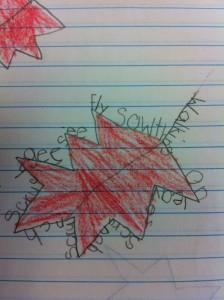How to Use Poetry to Transform Your Writing By Rochelle Melander
Always be a poet, even in prose. —Charles Baudelaire
Nearly every week, I teach poetry writing to children at the library. When they hear what we’re going to do, many panic: I can’t do that! I don’t know how to rhyme! And my favorite, But I don’t love anyone like that!
Last fall, I read a favorite poem to the group while they colored. When I finished, a 2nd-grade boy said to me, “Wait, I thought you were going to read a poem.”
“I just did.”
“That was a poem?”
“Yes.”
“That was good!”
“You sound surprised.”
“Can you read it again?”
I read it three more times. Afterwards, we wrote poems together.
Reading and writing poetry improves all writing. Poetry teaches us to pay attention to what’s happening in the world and how we describe it. We don’t have to be poets to use poetic tools to polish our storytelling. Here are three ways you can use poetic techniques to enrich your writing:
1. Add an image. Poets use images to help readers experience what’s happening in the poem. With metaphors, similes, sense words, and more, poets paint pictures for readers.
Your turn: Take one concept in your current work in progress. Instead of telling the reader about it, use an image to describe it.
2. Listen for music. Poets listen for the rhythm of language. When they construct a line, they place rhymes, repeat sounds, and count the beats of each word.
Your turn: Read your current piece aloud. How does it sound? Would adding internal rhyme, alliteration, or a different word improve how it sounds?
3. Say it shorter. Poets describe the universe with just a few perfect words. Sometimes, they offer us only a glimpse into their world. But because they use juicy words, it’s enough.
Your turn: Take a long sentence—25 words or more—and see if you can improve it by writing shorter.
Pro Tip: Reading poetry—even if you don’t understand it—will help you write better. If you’re a newbie, try one of these collections:
Poems to Learn By Heart edited by Caroline Kennedy. I picked up this delightful collection of children’s poetry at the library. Even if you don’t have a child in your life, read it aloud!
Dancing with Joy: 99 Poems edited by Roger Housden. This collection of poems from 69 poets offers a rich vision of what it means to experience joy.
Haiku Mind: 108 Poems to Cultivate Awareness & Open Your Heart by Patricia Donegan. If you can’t focus on a long poem, try reading haiku. These short, pithy poems help readers practice mindfulness. In this collection, Donegan reflects on each poem and provides a biography of the author.
[Tweet “How do you use #poetry tools in your writing? “]









